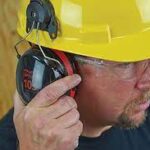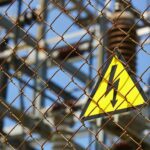Slips, Trips And Falls
Slip, trips and falls account for 1/3rd of all personal injuries in the workplace and are a top cause of workers’ compensation claims. The types of injuries incurred from slips, trips and falls include head and back injuries, broken bones, cuts and lacerations, sprains and pulled muscles.
The most common reasons for falls in the workplace are:
§ Slips— Wet or oily surfaces, occasional spills, weather hazards, loose rugs or mats and flooring that lacks the appropriate degree of traction.
§ Trips— Obstructed view, poor lighting, clutter, wrinkled carpeting, uncovered cables, uneven walking surfaces and bottom drawers not being closed.
There are three keys to preventing workplace accidents due to slips, trips and falls: good housekeeping, quality walking surfaces and proper footwear. Beyond that, employees should be reminded to take their time and pay attention to where they are going. They should also be encouraged to report areas where clutter, obstruction, spillage or damage have occurred.
Being Caught In Or Struck By Moving Machinery
Machinery that’s not properly guarded is a potentially grisly safety hazard. When body parts get caught in or struck by exposed moving parts or flying objects from machines without protective guards, the results are often disastrous. The long and horrifying list of machinery-related injuries includes crushed hands and arms, severed fingers, blindness and worse.
Most mechanical hazards occur in these three places:
§ The Point of Operation— Where work is performed on the material: cutting, shaping, boring or forming of stock.
§ Power Transmission Apparatus— Components of the mechanical system transmitting energy to the part of the machine performing the work: flywheels, pulleys, belts, connecting rods, couplings, cams, spindles, chains, cranks and gears.
§ Other Moving Parts— All parts of the machine that move while the machine is working: reciprocating, rotating and transverse moving parts, feed mechanisms and auxiliary parts of the machine.
The golden rule in preventing mechanical hazards is to remember that any machine part, function or process that may cause injury must be safeguarded. Also, existing hazards must be controlled or eliminated and proper operator training and protective clothing must be provided.
Transportation And Vehicle-Related Accidents
Where there is equipment, vehicles and large trucks, there’s the potential for vehicle-related accidents. These accidents include being struck or run over by a moving vehicle, falling from a vehicle, being struck by objects falling from a vehicle and getting crushed by or stuck under an overturned vehicle. Vehicle-related accidents are the most common cause of fatal injuries in the agriculture industry, but they can be equally catastrophic in industrial or manufacturing environments as well.
There are two distinct kinds of vehicle-related accidents.
§ On The Road— Workers can be injured or killed after being struck by a vehicle while repairing roads or other work in traffic zones.
§ In The Workplace —Operators of vehicles and equipment can be injured or cause injury to pedestrians.
Avoiding workplace transportation accidents begins with assessing who is at risk, as well as where and when these accidents most commonly occur. Only then are prevention measures, such as vehicle/worker orientation and safe systems of work, more easily established. You should focus on workplace design, ensuring layout routes always segregate pedestrians and vehicles and make any obstructions clearly visible. Directions, speed limit and priority signs are also helpful.
Fire And Explosions
Unexpected explosions and fires in the workplace are frequently caused by risk factors such as faulty gas lines, poor pipefitting, improperly stored combustible materials or open flames. The resulting injuries incurred include damage to the respiratory system, varying degrees of burns and potential disfigurement. Explosions and fires account for 3% of workplace injuries and have the highest casualty rate of all probable workplace accidents.
There are four types of injuries commonly associated with fires and explosions:
§ Primary Blast Injuries— Occurs due to the effects of pressure on body tissues, affecting ears, lungs and the GI tract.
§ Secondary Blast Injuries— Occurs when flying objects strike nearby workers.
§ Tertiary Blast Injuries— High-energy explosions can lift someone off the ground and cause them to fly into surrounding objects.
§ Quaternary Blast Injuries— Everything else that happens as a result of an explosion: crush injuries, burns and inhalation of toxic substances.
OSHA recommends following its hazard communication standards to help workers avoid fire and explosion injuries. In addition, material safety data sheets (MSDS) for chemicals should be kept on hand and employees should wear personal protective equipment at all times. Every workplace should have a clearly communicated evacuation plan and an effective alert system in place to quickly inform everyone of hazards and emergency situations.
Overexertion And Repetitive Stress Injuries
Although more subtle than a catastrophic explosion, musculoskeletal disorders are the most costly workplace injuries. Complaints of back pain alone cost employers an estimated $7.4 billion annually and lead to 100 million lost workdays annually. These kinds of injuries contribute to loss of productivity, millions in direct costs and millions in annual health benefit payout costs.
The financial impact on the employer is one thing, but the long-term effects on workers are often severe and potentially debilitating.
Overexertion injuries are related to pulling, lifting, pushing, holding, carrying and throwing. They account for nearly 33% of occupational injuries.
Similarly, RSIs (Repetitive Stress Injuries) are the fasting growing category of workplace injury and comprise more than 100 different types of job-induced injuries from wear and tear on the body. Both overexertion and RSIs are severe enough to inhibit simple activities with crippling and debilitating pain, not to mention severe impairment of movement. They may even eventually permanently impair a worker’s ability to perform his or her job.
Causes of overexertion and RSIs, include:
§ Improper Lifting— Bending at the waist instead of at the knees when carrying or moving heavy objects.
§ Manually Lifting Heavy Objects —Especially objects weighing over 50 pounds, without the assistance of a co-worker or lifting device (manual or mechanical).
§ No Breaks —With repetitive work, short breaks should be required, or the work may eventually result in too much wear and tear on the body.
§ Speeding Up the Line —Automation has created work conditions that are faster and often reduced to limited, repetitive tasks.
§ Intensive Keying —Constant typing and clicking strains muscles and tendons.
What should you do about overexertion and RSIs in your workplace?
Ergonomics — the science of adjusting the job to fit the body’s needs — provides injury prevention solutions that are simple and relatively inexpensive. Workers assigned to tasks that overexert or require repetitive motion should be required to take frequent short breaks to rest and stretch. Manual or mechanical lifting equipment should be provided, especially in cases where the items lifted are over 50 pounds. Varying workers tasks to break up the repetitiveness is also beneficial.
The best way to protect your employees and help prevent accidents and injuries in your workplace is to take a holistic approach to workplace safety. This means ensuring your employees have the proper protective equipment and adequate training to perform their jobs, while also making sure your facility is compliant with federal and environmental regulations.
Arbill can provide the equipment and training you need while also offering safety and environmental site audits that provide a comprehensive review of your policies and procedures. Schedule a free consultationwith an Arbill safety expert today and take the first step to ensuring your employees go home safely after every shift.


